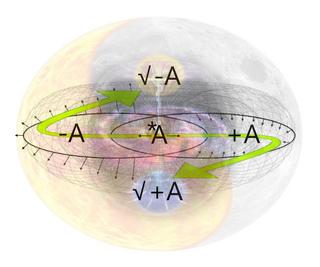Skepdick wrote: ↑Mon Jan 06, 2020 9:39 am
Motion is change. Change is about change over time. In a timeless universe there is no motion. No change.
Begs the question: Logically speaking what is time/change/motion? And you will arrive at calculus (or perhaps you have better ideas).
Time and space are reciprocal aspects of motion, which can either be in a state of change (ie. dynamic) or unchanged (ie. static).
3d space / 1d time
{reciprocates into}
1d space / 3d time
Thus:
solar day (24 hours) = t^1 as 1d time wherein space is immediate and 3d
solar year (365 days) = t^2 as 2d time wherein space is only relevantly 2d
great year *(25 920 years) = t^3 as 3d time wherein space is only relevantly 1d
___________________________________________________________________
*latter calculated by Plato viz. 360 days/degrees x 72, actual may vary
Thus time is merely a construct of abstraction, change is merely acceleration/scalar/deceleration given any arbitrary time, motion is the multiplicative reciprocity of time and space as the constituency(s) of the universe.
Then dead = (+ breathing) and alive = (- breathing). But that's incomplete. I could be holding my breath?
Sounds logical to me - I arrived at the same.
You are still breathing internally viz. heart is pumping.
If grounding breath into the breathing of the heart, the being can hold their breath without being "dead".
But you are now discriminating on different kinds of motion. Decay is still change (over time).
...dead/alive as (+/-)A resp. as in the logic above.
OK, then lets go back to Polish notation for this. Lets rewrite A = A as =(A, A).
You are saying it's not false. And it's not necessarily true. I'll ask a different question.
What possible values could the function =(A, A) produce?
I don't know what you actually mean by "values" but at best
status is being indicated: unchanged, which is a valid premise, thus true.
However, it is not necessarily true because A mandates its own reciprocate -A, which is also a valid premise: changed. The most fundamental √root of A is their own vitality, hence breathing (if even of the heart). Now look at this logic:
Let's say *A (granted natural capacity to be both/either (-/+))
is in space over time, denoted simply A = s/t.
*A = s/t
thus granting *A simultaneously to be +A and/or -A
________________________
+A = +s/+t (+relatively static)
-A = -(s/t), -s/t, s/-t (-relatively dynamic)
wherein:
+A is (relatively static) one-dimensional time t, and
-A is (relatively dynamic) three-dimensional space s, thus
*A is
simultaneously subject to/of the (e)motional aspect(s) of
space, s, and time, t.
_________________________________________________________________
s, as 3d space: for practical purposes of (meta)physical "orientation", and
t, as 1d time: for purposes of (meta)physical "science(s)", and
*A is locally relative to s/t according to its own potential/actual (-)impetuses and (+)impedance(s)
A thus mandates the capacity to reciprocate. For example, our lungs have a relationship to the trees on the planet: what we exhale, they inhale etc. Therefor, breathing bodies such as ours
mandates reciprocation, thus A, if a
valid universal variable, must be granted what the universal naturally grants such bodies what is known to be essential: reciprocity of in/out. In as much, =(A, A) is simply a status, thus true in that context, however also false if it excludes -A as intrinsic to the identity.
It's not equivalent. It's the inverse. Again in Polish notation...It's all just term replacement/rewriting.
I don't follow the notation, nor the logic.
Then you could consider yourself a supporter of MUH
I don't agree that the universe is mathematics, rather mathematics is a language can be used as a projective means to model/describe the universe, which is of motion. If given space and time, the rest is relationship(s) relating to motion(s).
Spacetime are abstract Mathematical concepts. Spaces are geometries, time is a vector. We use Mathematics to describe reality. But Mathematics is still a language. And languages have limits...
Another perspective on motion (change over time) and space-time is Computer Science which takes keen interest in space-time complexity.
Being abstract, they can not bend, hence GTOR is nonsense. If taken as abstractions, they can be seen as aspects of motion: yin (space) and yang (time) wherein each body has their own local impetus.
The inference rules of your logic.
What is this referring to?
You still need a state transition diagram.
I already have it - they are universal roots and operators intrinsically assigned to *A.
*A = √(+all, -not), √(+to cause, -to cease)
A has the universal root(s) whence all are subset:
causation of: (all / not) = to be, or
cessation of: (all / not) = not to be
wherein the universal root of their relative spacial-temporal impetus/impedance is their own will.
A can now transition according to will in any space-time-invariant context once given a choice.
